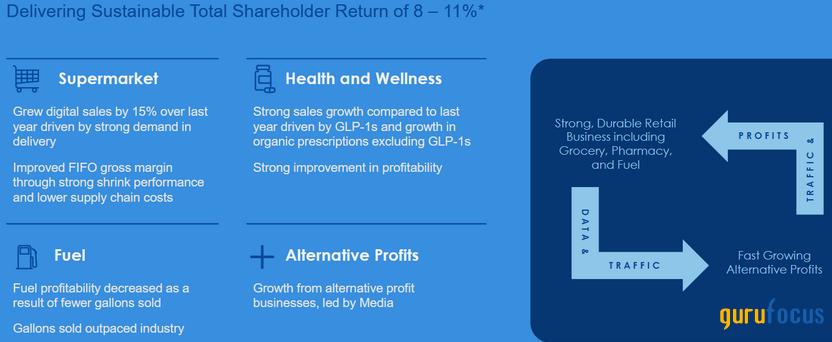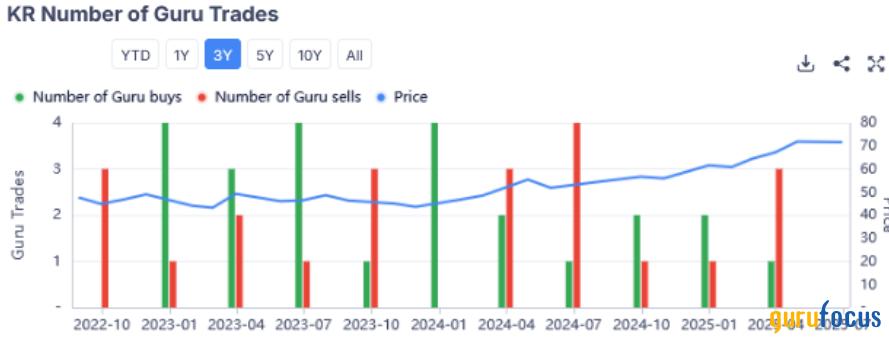The Kroger Co: A Solid Compounder Hidden Behind Grocery Giants
The grocery and supermarket industry is viewed favorably by some investors and with greater caution by others, and the reason is practically the same. Companies in this sector are generally very solid and tend to grow at a slower pace, following the famous steady and slow model, and also have low margins. In this industry, which includes Walmart WMT and (especially) Costco
COST, it is easy to overlook solid companies that attract less attention, such as The Kroger Co.
KR.
But the company also has some positive points and is a possible alternative with the potential to create shareholder value, due to good prospects, solid moats, and a fair valuation.
All of this, even with some points of uncertainty and a complex environment amid the collapse of the deal with Albertsons (ACI), leads me to believe that Kroger can be a compounder, but with some caveats.
Kroger Offers Resilient Growth
Kroger is one of the largest supermarket companies in the US. Its market share is ~10%, slightly above Costco but still far from number 1, as Walmart has just over 23%. A notable point is that in recent years Kroger has been losing some market share to these two competitors, which already reveals a little of the competitive landscape. Despite this, it does not mean that Kroger is a bad company, since in recent years, the loss of market share was because it grew its revenue a little less, while Walmart and especially Costco grew at a faster pace.
To substantiate the quality of Kroger's model, we need to look beyond market share. A comparison of efficiency metrics reveals a company that is very efficient in managing its cash flow. For instance, Costco's CCC (Cash Conversion Cycle) is at 3.4 days, and Walmart's is at 4.5 days, while Kroger's CCC is negative, meaning it collects cash from its customers before it has to pay its suppliers for that inventory, which creates a float, almost like an interest-free loan. It also means that revenue growth not only does not require capital, but generates capital.
| Company | Revenue Per Employee | CCC | DPO |
|---|---|---|---|
| Costco | $807,000 | 3.4 days | ~30 days |
| Kroger | $360,000 | -3.7 days | ~27 days |
| Walmart | $324,000 | 4.5 days | ~43 days |
I believe it can be a potential compounder because the company has already achieved relevant moats, such as scale, bargaining power, logistics, brand power, and the like. It has built a business model that is practically an ecosystem, and as the slide below shows, it has a clear value creation model. Considering the same price-to-earnings ratio for the coming years, the shareholder return target is 8%11%, supported by growth in digital sales (as illustrated by the 15% YoY), growth in health and wellness and margins, as well as optionalities such as the retail media network. It is a complete flywheel enabled by scale and complementing the business.

The Q1 2025 earnings prove that this is working, even in a more complex environment. There was 3.2% growth in identical sales (ex-fuel), 15% growth in digital sales, and a 4% increase in adjusted EPS to $1.49.
This also led management to increase full-year sales guidance. As mentioned in the earnings call, this success is being driven by a renewed focus on the core:
"Grounded in these principles, my priorities in this role are to position Kroger for long-term growth, accelerate top line sales and run great stores... We're directing investments toward projects that will grow our core business, including plans to accelerate new store openings."
Another very interesting point is the ~$37 billion our brands business, which is growing faster than national brands. This, combined with a solid balance sheet (with debt/EBITDA of 1.7x) and this commitment to return shareholder value via dividends and buybacks (with cash flow allowing for this), paints a picture of a company that has an appealing future.
The Albertsons Merger and Other Risks
There are some points of concern for Kroger's thesis, even though it is possible to envision this bright future. The first and most latent is the competitiveness of the scenario. Taking the LTM timeframe, Kroger's revenue decreased by 2%, while Walmart grew by 4% and Costco grew by 6%. The 5-year CAGR also shows a similar picture. Kroger posted a CAGR of 3.8%, while Walmart delivered 5.4% and Costco 10.75%.
This is a fragmented industry, so competition will always exist, and since Kroger already has a relevant scale and a solid business model, this mitigates the risk that competition will significantly deteriorate its business model, either by decreasing its revenue or putting pressure on its margin. This is not a winner takes it all market, but it is still a risk to be monitored as Costco and Walmart continue to consolidate.
This ultimately goes through the failed Albertsons merger, whose consolidation attempt ended in a somewhat bitter collapsed deal with Kroger accusing Albertsons of secretly coordinating with C&S to undermine the regulatory strategy, while Albertsons claims Kroger had a classic case of buyer's remorse.
This legal mess is a significant distraction, creates headline risks, some legal costs, requires management attention, and so on. But still, it does not detract from the company's value or its long-term potential.
As for the other risks, most apply to the entire industry, such as inflationary pressure, labor costs, strategy execution, and the aforementioned competition.
Divided Gurus
Recent guru trading activity shows that some managers may be more fearful of the company in general or even more cautious due to the merger news, while some value investors are stepping in.
Ken Fisher (Trades, Portfolio), for instance, recently reduced his position. But Joel Greenblatt (Trades, Portfolio), famed value investor, seems to have seen an opportunity to increase exposure in the last quarter.

In any case, there is a noticeable division among the gurus, which causes some mixed feelings, but with a certain endorsement from good investors.
Kroger's Compelling Valuation
One of the main points that make me optimistic about Kroger is its valuation. To be honest, the choice between Costco, Walmart, and Kroger, without mentioning valuation, seems obvious. Costco has the most reliable prospects and the most apparent compounder. Walmart also has incredible prospects. And Kroger would take third place.
But the valuation balances this out well.
Kroger's forward price-to-earnings ratio is 14.6x. That's less than half of Walmart's multiple, which is 37x, which is still much lower than Costco's, which is over 50x.
The price-to-operating-cash-flow ratio also suggests a too big asymmetry. Costco's is 35x, Walmart's is 21x, and Kroger's is 8x.
Costco and Walmart are better than Kroger, but the necessary question here then is, are they worth a premium between 2x and 3x higher than Kroger? I believe Kroger has the potential to close some of that valuation gap.
In any case, when analyzed separately, these are very interesting multiples if we take into account that the company should continue to increase its revenue by something close to low or mid single digits and has the potential to expand its margin and increase its EPS even further, also due to buybacks.
The Bottom Line
Kroger is a prime example of a solid business being overshadowed by great companies. The failed Albertsons merger is a bit noisy, but it does not change the fundamental strength of Kroger's operations, nor the prospects. The company is executing well, growing, expanding its digital business, and returning significant cash to shareholders.
Therefore, even though there are more appealing alternatives, I have an optimistic view for Kroger, but with the caveat that execution must be monitored due to the competitive landscape.